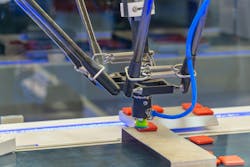The past 40 years has seen an exponential growth in the makeup of a control system and never more so than in the packaging machinery industry. I had the good fortune of stepping from my college education in the late 1980s straight into a position with a startup automation company. That company is now one of the most prestigious integrators in North America. My experiences during that tenure laid the foundation for what has been a very rewarding career.
One the most memorable events for me was an emergency call to a local automotive assembly plant in their hour of need. The plant made the Ford Crown Victoria, mainstream car of choice for police cruisers and commercial taxi companies all over Canada and the United States. While I did not attend the call in person, the description of the event captivated my imagination and further solidified my decision to make my career in the automation industry. The assembly plant, during those years, was producing nearly 30 cars per hour. One part of the assembly was the placing of the windshield and rear window of each vehicle. To make this happen, a company developed a robot—a pair of them actually—to pick and place the window on the frame of the vehicle as it passed down the assembly line.
One robot would pick the window off the supply rack and flip it over. The second robot would lay down a glue bead on the back of the window. It even gave a little snap of the bead just like a human would do to break it loose from the applicator. The first robot then flipped the window back over and carefully located it with respect to the frame before pressing it into position.
The event that brought our company into the fold is the vendor had left for the day and the placement robot was acting up. It would do all of the operation perfectly but erred on the last step by overpressing the window right through the threshold of the car frame. With a production rate of a car every two minutes, this function needed to be quickly fixed, and it was.
This early version of a Cartesian or gantry robot in production used a multi-axis motion controller that resided in the rack of the controlling programmable logic controller (PLC). Much of the success of such a system was entirely in the realm of the person programming the application, as we had to consider all of the axes interacting with each other.
Robotics have come a long way since those days and, thankfully, robots today usually have their own controller and all of the motions of the various axes are monitored and the software prevents the hardware from making moves that would cause damage to the robot or the environment that it is performing in.
Cartesian robots move using three axes—x, y and z—that are perpendicular to each other. By using a blended or interpolated move, one can achieve nonlinear movement, but it is not that efficient.
Cartesian robots are also limited in that all movements must be within the supporting frame of the three axes of motion. They can be mounted horizontally or vertically, depending on the application.
A key development in robotics came with the addition of a rotary axis. Moving like a Cartesian robot, selective-compliance-articulated-robot-arm (SCARA) robots add a fourth axis, Theta, to provide rotation at the end of the z-axis, like a wrist at the end of an arm.
Going even further, a six-axis robot adds more rotation to move forward/back, up/down and yaw, pitch and roll. Imagine holding your hand out in front of you with your palm facing down. Yaw would be the action performed by turning your hand to the left and right while keeping your palm facing down. Pitch would be the action performed by tilting your hand up and down from the wrist. Roll is the action performed if you rotate your hand left or right while keeping your wrist locked in position and turn your forearm with your hand. The actions can be compared to using your whole arm, from shoulder to fingertips to manipulate objects.
All three types of robots are very prevalent in automation and, especially, packaging machinery. One such example would be a palletizing robot. Both a gantry Cartesian or six-axis robot could be used for this purpose. Cases or bags of product present themselves from a production line. A robot then picks up each case, or more than one, and orients them on a pallet of finished product in a pattern that creates a solid cube when multiple layers are formed. Since these cases or bags can be heavy, this is a great application for a robot.
Another example would be for packing bakery products in a pre-formed tray. For this action, some accuracy is required, and the product is likely delicate. A delta robot might be a good choice for this application. A delta robot is similar to a gantry Cartesian robot in that it uses three axes for action.
In the case of the delta robot, the three axes are mounted on a trestle base above the work surface with joints and long “legs” that create parallelograms that are attached to a common ring at the base. The end-of-arm tooling (EOAT) is mounted on that ring. The robot looks not unlike a spider with its legs extended down below the base mount. A great deal of accuracy and finer movements can be achieved with this type of robot because the axes themselves do not move, just the appendages attached to them.
In most cases, a vision system accompanies this application. The camera or cameras are used to identify the location of the product on a conveyor belt. The robot then picks up the object, in the correct orientation, for placement in the tray.
Robots are also used for case-packing applications. Some may use a simple gantry robot to pick and place cartons into a case while others might use a six-axis robot mounted with the base vertical to reach out and collect pouches off the end of a conveyor and collate them for placement into a case located below the infeed section.
The six-axis operations tend to be more expensive up front but allow for much more flexibility in the placement of the product in the case, allowing for multiple rows or even alternating layers when the product is wedge-shaped.
A discussion about robots in packaging would be remiss if we forgot to talk about the exponential trend in the use of collaborative robots (cobots). They are designed for use in the same workspace as people. Sometimes the cobot will replace an actual person while in other applications it might work in unison with that person. The key element is the human element. Since these are machines that are working where humans are also working, there are a number of safety features built in to make it safe for the person to be in close proximity.
Cobots have built-in torque sensing devices that will detect even a minute resistance to normal, commanded movement. This will cause the robot to slow down or even stop and back up if it senses that it has bumped into something.
Other technology includes paint that is conductive when touched. Sensors connected to the actual paint layer will detect the increased conductivity that would happen if the surface of the robot makes contact with skin. Human skin is moist, by nature, and the paint layer is activated by this property.
Additional technology on a cobot includes breakaway guards. These guards are usually plastic and trigger a sensor when correctly in place. If the guard collides with something with enough force to dislodge the guard, the robot immediately stops and cannot be restarted until the guard is back in place and the sensor detects it.
Since the cobot is expected to work in close proximity to a human, additional sensors are used to determine if the human or an object is in the normal working envelope of the robot. Area scanners and contact mats can be employed to identify the normal envelope and notify the cobot if that area is breached. The relative severity of the breach—arm’s length or more vs. close to touching—can cause the cobot to slow down, rather than stop its commanded function. This allows for the critical stop functions to happen more quickly while still allowing for the continuation of the intended move. Once the human or object is no longer in the safe envelope, the cobot resumes normal speed.
This collaborative nature comes with a bonus from a machine-design point of view. Conventional robots required a hard guard around not only the actual work envelope but the absolute reach of the robot itself. This can mean a very large, physically guarded area that takes up a lot of floor space. With the use of cobots and area scanners, much of this floor space can be safely reclaimed.
Robots are here to stay in packaging machinery, and the only limit on use is in the mind of the designer.
About the Author
Rick Rice
Contributing Editor
Rick Rice is a controls engineer at Trew Automation, a material handling manufacturer based in West Chester, Ohio. With over 38 years’ experience in the field of automation, Rice has designed and programmed everything from automotive assembly, robots, palletizing and depalletizing equipment, conveyors and forming machines for the plastics industry but most of his career has focused on OEM in the packaging machinery industry with a focus on R&D for custom applications.
Sign up for our eNewsletters
Get the latest news and updates

Leaders relevant to this article:

